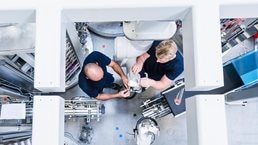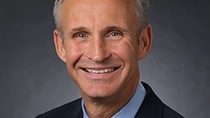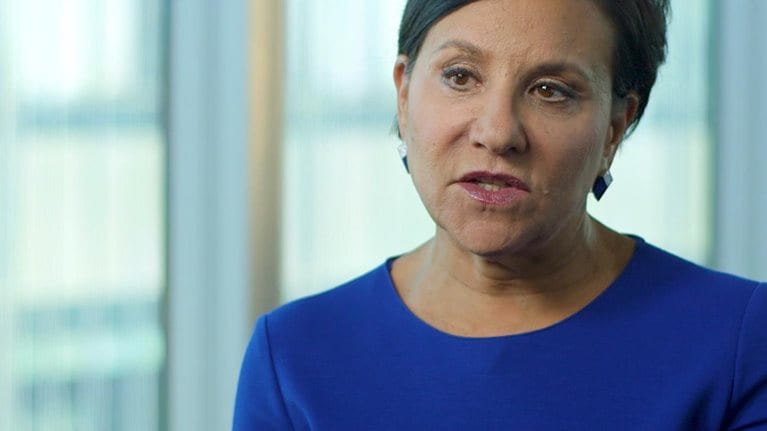Structural changes in the labor market, including an aging population and the rise of the gig economy, have created a persistent skills gap for employers. This mismatch in talent has become a top challenge for businesses, educators, and policy makers. Businesses understand that a predictable supply of workers is critical to their growth and viability. Policy makers are seeing that persistent underemployment and a lack of opportunity deepen economic inequality. And educational institutions are experiencing increasing demands from organizations to tailor their offerings to the demands of industry. As a result, all are motivated to create a 21st-century workforce that can serve both business and society. The major question is how these groups can work together to address common goals.
Stay current on your favorite topics
McKinsey recently sat down with Jonas Prising, chairman and CEO of ManpowerGroup, to discuss changes in the labor market and how organizations should adapt. Prising shared his thoughts on identifying skills adjacencies and opportunities for upskilling, partnering with educational institutions, and hiring based on an employee’s ability to learn as opposed to current skill sets.
Interview transcript
McKinsey: What changes do you see happening in labor markets today?
Jonas Prising: We don’t believe labor markets are about to shift from 40-hour, full-time employment to a freelance economy. Instead, we see increased segmentation, with many more ways of how work gets done.
The labor market started as a primarily full-time employment economy; then part-time was added. Our own contingent work and temporary staffing became an option. Then freelance work came for many of the creative skill sets. And now we also have this ability to tap our work resources to create a just-in-time, on-demand economy. We think it’s really an evolution in a spectrum of opportunities that individuals will choose to pursue, in different ways and at different points, depending on their personal preferences and circumstances.
McKinsey: How have employers responded to these changes?
Jonas Prising: Over the past 20 years, organizations have been consuming labor and not growing talent. We need to think differently about attracting and growing talent internally. We need to move away from a model of “come to us and we will employ you for the next 40 years” to “come to us and after three to five years we promise you will have acquired skills.”
Organizations need to develop skills in employees that make them more marketable and employable inside the organization but that also make them more marketable and employable outside of the organization. And that is really the shift in employer brand promise that we see occurring.
What we need to be aware of is that most of our legislation and support structures are aimed at the traditional, full-time employment model. That’s where we see a lot of the evolution that needs to occur, so we can facilitate the ability of individuals to leave certain roles, move to others, and still feel that they can make a living and achieve their quality-of-life objectives. We also see that individuals with in-demand skills are making different choices in terms of who they choose to work for and why.
McKinsey: What are some of the innovative approaches to talent development that you’ve seen?
Jonas Prising: We think understanding skills adjacencies is a big frontier that will emerge as a result of data and artificial intelligence. We can now look at a person’s profile and understand that without too much intervention and support she can acquire a new set of skills that will make them tremendously more employable.
Last week I had the great opportunity to participate in the graduation of a class of veterans who attended the Academy of Advanced Manufacturing, which is an initiative we created with Rockwell Automation, a global leader in automating manufacturing equipment, and other content providers. It’s a collaboration where we began by mapping the skills needed for future manufacturing roles together with the Digital Manufacturing and Design Innovation Institute in Chicago. We selected three specific roles that are the most in demand for those future skill sets. Then we selected veterans and took them through a rigorous three-month course that combines soft-skill training and technology training.
In the end, our placement rate was north of 95 percent. More important, those individuals are now not only finding jobs but they’ve created career paths for themselves that will take them further for many, many years—maybe even decades. It was really gratifying to see that in a very short period of time, individuals were able to acquire new skills that doubled, or in some cases tripled, their income.
We think understanding skills adjacencies is a big frontier that will emerge as a result of data and artificial intelligence.
McKinsey: Do you have other examples where skills adjacencies have helped to create new pools of talent?
Jonas Prising: In Italy, a lot of the textile workers have been displaced due to competition from China, which offers lower cost, faster delivery, and a just-in-time economy. At the same time in the same region, but in a very different industry, composite materials were starting to take off as a very important component for car manufacturing. The problem is it’s a highly skilled manufacturing process and quite manual.
We were able to identify that the textile manufacturing workforce is the ideal workforce or talent pool for these jobs because it has the ability for precision-based interventions, just as you need when you are dealing with composite materials. A short cycle of training enabled the workers to shift from the textile industry and its associated skills to a completely different industry where the demand for those skills is extremely high.
Now, if you would have said to us, “Look, we think the best place to find manufacturing talent for race cars is going to be the laid-off textile workers 50 miles from here,” we would have said, “No, we don’t think so.” But we identified that these were actually adjacencies that could be really useful, and it has turned out to be a great success story for those workers and, of course, for the companies that now have a much wider talent pool.
It’s really about partnering with stakeholders and providers that have different levels of expertise and capabilities and then putting it all together.
McKinsey: What other trends are you seeing in terms of reskilling and upskilling?
Jonas Prising: We believe that the next evolution of assessments capability is going to be in what we call LQ—the learnability quotient. Your future employability is not going to be based on your hard skills and soft skills but on your ability to acquire new knowledge as you evolve in your career. You don’t get to a finish line when you’ve completed a degree; it’s truly a journey of lifelong learning that’s going to make you more employable and more marketable.
We’re very excited about the promise of predictable performance based on data analytics in this area as well. That’s the assessment that ManpowerGroup has been working on—predicting performance based on somebody’s ability to acquire new knowledge and their innate curiosity as they move forward in their career. That’s what’s going to drive their future career prospects.
McKinsey: How do educational institutions need to adapt to ensure their graduates can participate meaningfully in the economy?
Jonas Prising: Our general approach to training and workforce development in the US is when I need the person and talent, I will go into the market and I will find them. What organizations are seeing now is that they’re not able to just find people because the talent is not there at scale. And looking ahead it won’t be there at scale.
I think the whole approach to education will shift as we come to understand what kinds of skills—and what level—are needed for certain roles. In some cases, it’s going to be a four-year college degree. In other cases, it’s going to be a two-year vocational degree. And in other cases, it’s going to be a series of stackable certificates that are going to enable individuals to move forward in their careers in the way that they choose.
Education needs to move to a model that is faster and more specific to an outcome—that is, developing somebody who is employable. The evolution of education is going to involve shorter bursts with more tangible outcomes. And maybe also a more iterative process that matches the evolution of the changes in skills that are occurring in the workforce.
McKinsey: What is the role of business in facilitating the shift in the education model?
Jonas Prising: Currently we have people who come out of schools ready to graduate, but they may not be ready to work, and that, I think, is why the collaboration between the private sector and educational institutions has to become much tighter.
On the employer side, they are notoriously poor at predicting future demand for skills. And if they were poor before, it will be even worse in a rapidly changing environment. Closer communication between educators and employers is occurring in some parts of the world, but we clearly have a long way to go in a number of nations, including the US, to make sure that these connections are stronger than they are today.
Most organizations today understand that having access to skilled talent is what’s going to make or break their business strategy. That’s true for large organizations, medium-sized organizations, and smaller organizations. But one of the challenges, of course, is large organizations have resources to develop training on their own. Smaller organizations don’t—not to the same degree.
We see many smaller organizations collaborating with educational institutions in a more focused and intense way. Some of these organizations are going into high schools and talking about the future of work. They’re engaging young people in earn-and-learn programs—a form of apprenticeship where they pay young people to come in and learn about their activities—and then the students go back to school but stay in touch with the organizations so they can enter the pipeline. I think the advice to employers is to take their workforce strategy as seriously as they take their business strategy.

Supporting job growth and worker prosperity in a new era of automation
McKinsey: Can you elaborate on the role of technology and data in addressing skill gaps and aiding in hiring?
Jonas Prising: The acquisition of knowledge is going to be facilitated because, through technology platforms, access to content will be ubiquitous. The big change will then come in how we help people acquire that content. Instead of displacing human capital, technology will augment human capabilities. And ultimately that’s what is so exciting.
I was recently in France where a lot of our business is related to infrastructure construction and I participated in a training class on using technology. In construction, one of the big issues is worker safety, which is really hard to teach. Learners either complete a hands-on walk-through on-site or they read a manual and are given examples of what not to do.
With the advent of technology, we now have virtual-reality training. We can use goggles to explore a work site, look at certain danger areas, and make choices on what actions to take or what constitutes danger. And all of this is done in a much more efficient way for our associates and also in a more effective and engaging way that ultimately results in lower workplace incidents on construction sites. I think it’s an exciting manifestation of what we mean when we talk about a skills revolution and how we can leverage technology to bridge the gaps that we all see in our societies today.
Making decisions based on data is as yet an extremely underdeveloped skill, both on the part of individuals and organizations as they go about hiring. We think that’s going to be the big next evolution that drives change in organizations.
I think the advice to employers is to take their workforce strategy as seriously as they take their business strategy.
McKinsey: Ensuring that the economy has a sufficient pool of qualified workers is such a far-reaching challenge. What gives you confidence that the issue can be addressed adequately?
Jonas Prising: The reason I’m so passionate about workforce development is I can see how things are moving right now. The workforce is bifurcating between workers who have the skills they need and those who are at risk of being left behind. We must address this issue. And I’m fortunate enough to be at an organization where we can bridge the gap between people who are looking for meaningful and sustainable employment and employers that are looking to find and have access to skilled talent.
This moment is very similar to the 1860s, with the advent of the steam engine and all the changes to the economy and work we saw then. When we look back 20 years from now, we’ll say this is when the shift really happened, when globalization and technology drove tremendous societal change, altered how companies operated, and changed how we as individuals thought about what work means to us and how we want to engage. That’s why it’s so gratifying to be here at this moment in time.



